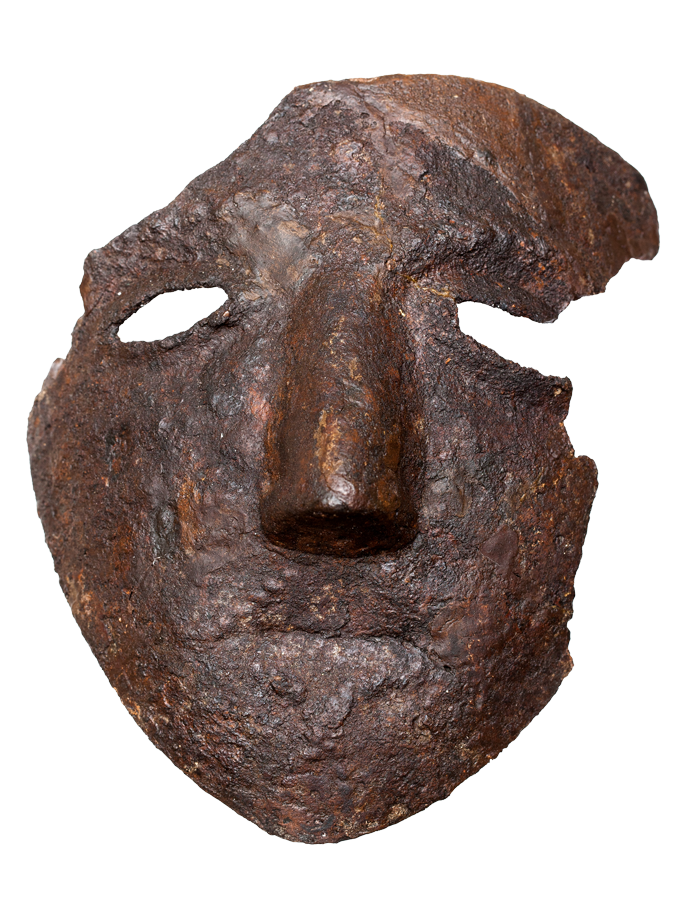THE GUISE - ANTHROPOMORPHIC HELMET VISOR (BATTLE MASK FROM THE HELMET)

The mask represents the human face of the European type – with a retreating forehead, a straight nose, a prominent brow ridge, wide eyebrows detailed with inclined notch, a compressed mouth with a small mustache.
The mask is relatively well preserved, there is no edge of the left side and the upper corner of the right side of the mask.
In the literature two points of view on functional belonging of masks are stated. Some researchers considered them an attribute of religious rituals common among nomads. More justified and now generally accepted is the point of view of the well-known Russian archaeologist A.N. Kirpichnikov, who considered such items to be battle masks, which were attached to the bottom of the helmet with a hinge.
The battle mask found in Serensk is one of the two masks originating from the territory of Ancient Rus’. The second, highly fragmented mask was found during the examination of the ancient Russian settlement near the village Shepetovka (Khmelnitskaya Oblast. Ukraine). Besides territories of the Ancient Rus’, battle mask were found during excavations in Tauric Chersonesus, and in burial mounds of nomads.
Serensk is a village in a Meshchevsky district in the Kaluga Oblast. On the northern outskirt of the village is placed the hillfort “Serensk”– an archeological site of the federal importance.
From the beginning of the first millennium AD on the place of the hillfort a well defended settlement of the Moshchino culture existed. In the XI century Viatichi (East-Slavic tribal confederation) settled in here, increasing the area of the defended settlement. From the XII century the suburbs of the city belonged to the Principality of Chernigov. For the first time the city is mentioned in the “Pereslavl-Suzdalian chronograph” under the year 1208. In 1238 the city was sacked by Batu. The cultural layer on the hillfort can be traced till the XVII century.
The first excavations on the hillfort were made in 1898. In 1965-1985 on the hillfort worked the Upper Oka expedition of the institute of archeology of the Academy of Sciences of the USSR leaded by T.N. Nicolskaya, in 1986–1989, 1997–1998 – the Kaluga Oblast local history museum’s archeological expedition led by T.M. Hohlova.
The area of the hillfort is about 4 hectare. It includes the citadel and the surrounding city fortified with strong ramparts and ditches. A trading quarter was placed around the fortified city (the total area of settlements is more than 25 hectare) and slobodas (large villages) were placed on the opposite bank of the Serena river (on the territory of the modern village Nikolskoye).
During the archeological research were found iron-melting furnaces, a hearth, casting moulds with Cyrillic inscriptions for making hollow accessories (kolts, beads, temple rings), workshops for making jewelry, glass bracelets and rings – glass accessories were made in purple color. A rich material was gathered: household items made of iron (knives, locks, keys, tinderboxes, scissors), jewelry made of bronze, copper and silver (temple rings, rings, bracelets, torcs), weapons (tips of spears and arrowheads, maces, fragments of plate armor, battle axes, mask from the helmet), etc.
